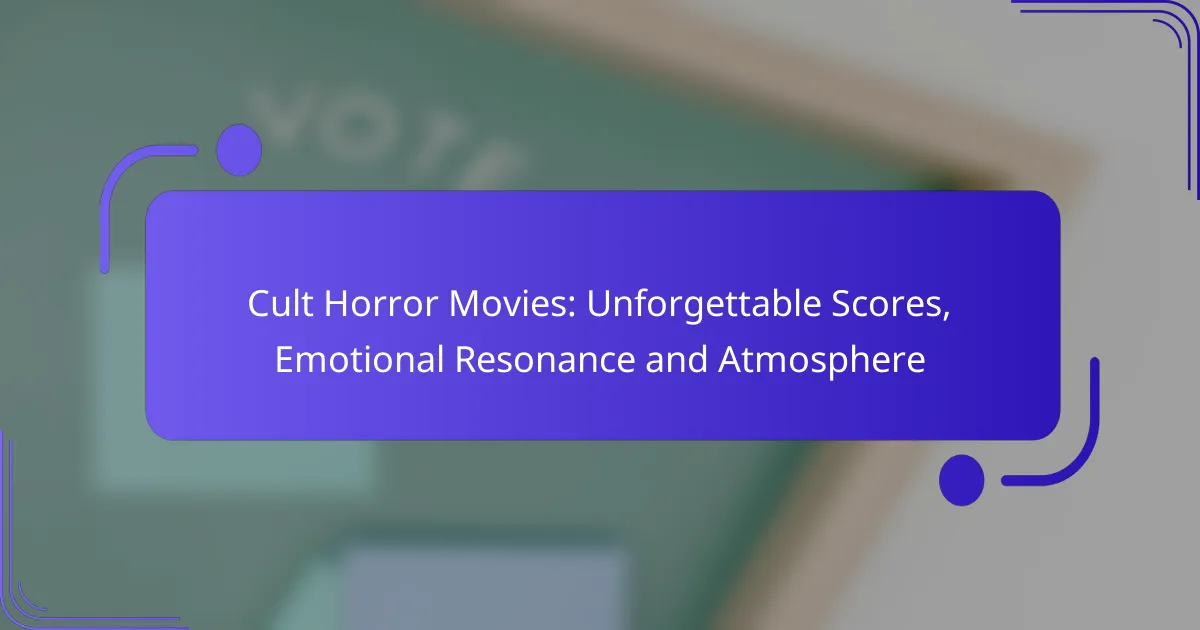Cult horror movies are renowned for their unforgettable scores that amplify the eerie atmosphere and emotional depth of the narrative. These soundtracks not only enhance the viewing experience but also play a pivotal role in shaping the films’ identities, evoking a range of feelings from fear to empathy. By intertwining visual aesthetics with sound design, these films create an immersive environment that lingers in the minds of viewers long after the credits roll.
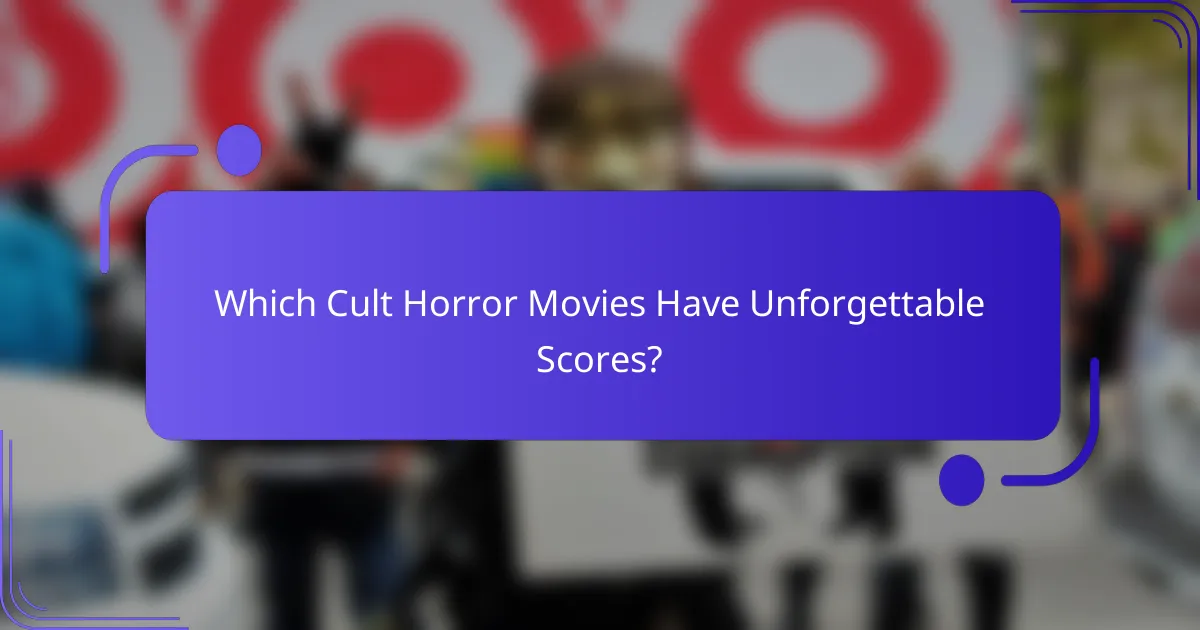
You can learn more in Cult Horror Movies: Unforgettable Scores.
Which Cult Horror Movies Have Unforgettable Scores?
Cult horror movies often feature scores that enhance their eerie atmosphere and emotional depth. These soundtracks not only elevate the viewing experience but also leave a lasting impression, making them integral to the films’ identities.
The Shining (1980) – Wendy Carlos and Rachel Elkind
The score of “The Shining,” composed by Wendy Carlos and Rachel Elkind, is renowned for its unsettling blend of electronic and orchestral sounds. The music amplifies the film’s psychological tension, creating a sense of dread that permeates the narrative.
Key pieces, such as the use of dissonant tones and haunting melodies, contribute to the film’s chilling atmosphere. The score’s ability to evoke fear without relying on traditional horror motifs sets it apart as a memorable element of the film.
Halloween (1978) – John Carpenter
John Carpenter’s score for “Halloween” is iconic, characterized by its minimalist piano melody and steady, rhythmic pulse. This simple yet effective composition builds suspense and has become synonymous with the slasher genre.
The use of repetition in the score mirrors the relentless nature of the film’s antagonist, Michael Myers, enhancing the feeling of impending doom. Its influence can be seen in countless horror films that followed, establishing a template for effective horror music.
Suspiria (1977) – Goblin
The score features haunting vocals and pulsating rhythms that heighten the film’s visual horror, ensuring that the music remains as memorable as the imagery. Its unique sound has influenced many filmmakers and composers in the horror genre.
Hereditary (2018) – Colin Stetson
Colin Stetson’s score for “Hereditary” is marked by its use of unconventional instruments and techniques, creating an unsettling sound that reflects the film’s themes of grief and trauma. The music builds tension through its dissonance and rhythmic complexity.
Stetson’s ability to evoke a visceral emotional response through sound makes the score a crucial component of the film’s impact. The score’s haunting quality lingers long after the film ends, reinforcing its status as a modern classic in horror.
Get Out (2017) – Michael Abels
Michael Abels’ score for “Get Out” combines orchestral elements with African-American musical traditions, creating a unique sound that enhances the film’s social commentary. The music effectively underscores the tension and horror of the narrative.
Abels uses motifs that reflect the protagonist’s psychological state, making the score an integral part of the storytelling. Its innovative approach has garnered acclaim, contributing to the film’s critical success and cultural relevance.
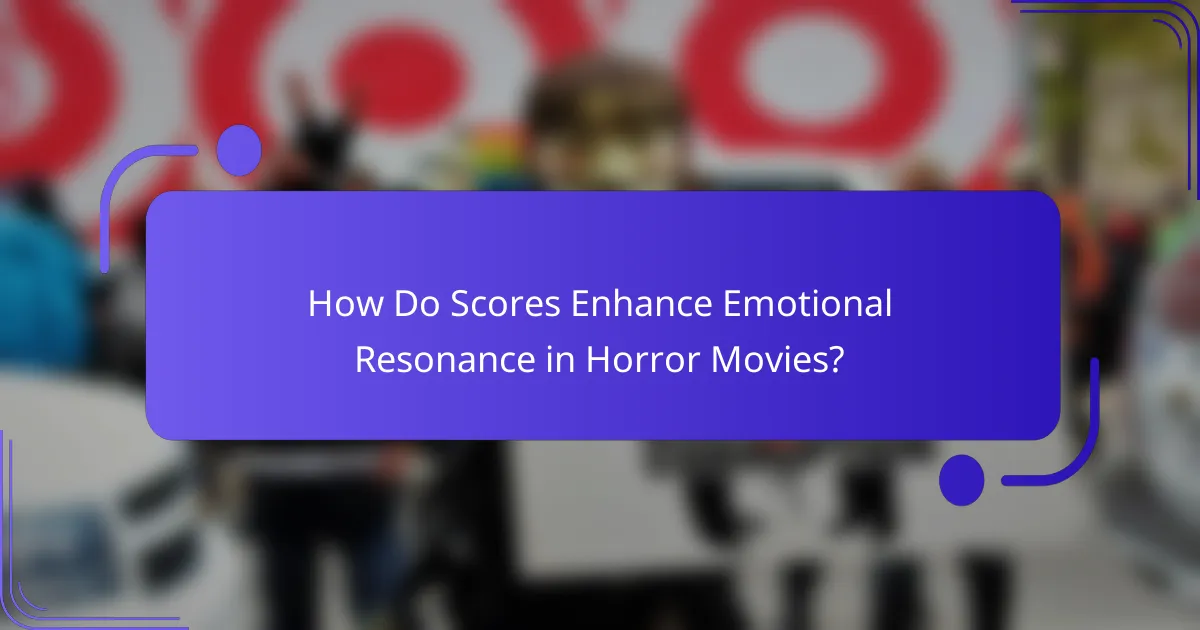
How Do Scores Enhance Emotional Resonance in Horror Movies?
Scores play a crucial role in enhancing emotional resonance in horror films by manipulating audience feelings and reactions. The right music can evoke fear, suspense, and empathy, making the viewing experience more intense and memorable.
Building Tension and Anticipation
Scores effectively build tension and anticipation through the use of crescendos, dissonance, and rhythmic patterns. For instance, a gradual increase in volume or tempo can signal an impending scare, keeping viewers on edge. Composers often utilize silence or minimalistic sounds to create a sense of foreboding, making the eventual payoff more impactful.
In many horror films, the use of staccato strings or unsettling electronic sounds can heighten anxiety, leading audiences to brace themselves for shocking moments. This technique is particularly effective in scenes where the protagonist is unaware of the lurking danger.
Creating Atmosphere and Mood
The score is instrumental in establishing the overall atmosphere and mood of a horror movie. Dark, brooding compositions can evoke feelings of dread, while lighter, dissonant melodies may create an unsettling contrast that enhances the horror elements. For example, a haunting piano piece can underscore a ghostly presence, immersing the audience in the film’s eerie world.
Moreover, the choice of instruments plays a significant role in shaping the film’s tone. Strings, woodwinds, and synthesizers can all contribute to a unique soundscape that reflects the film’s themes and settings, whether it’s a haunted house or a psychological thriller.
Influencing Character Perception
Scores can significantly influence how audiences perceive characters in horror movies. A character’s theme music can evoke sympathy or fear, shaping the audience’s emotional response. For example, a soft, melancholic score may elicit empathy for a troubled character, while a harsh, jarring score can signal danger or malevolence.
Additionally, the use of leitmotifs—distinct musical phrases associated with specific characters—can deepen audience engagement. When a character appears on screen, their theme can trigger an emotional reaction, reinforcing their role in the story and guiding viewer expectations.
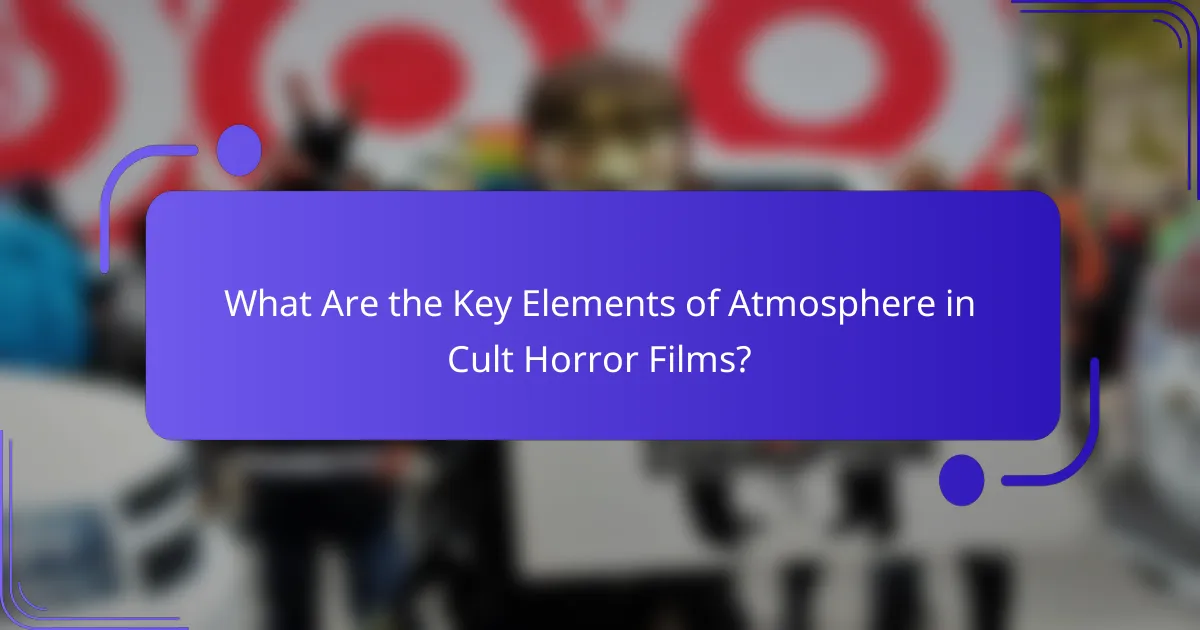
What Are the Key Elements of Atmosphere in Cult Horror Films?
The atmosphere in cult horror films is primarily shaped by visual aesthetics, sound design, and setting choices. These elements work together to create an immersive experience that evokes fear, tension, and emotional resonance.
Visual Aesthetics and Cinematography
Visual aesthetics play a crucial role in establishing the mood of cult horror films. The use of color palettes, lighting, and camera angles can significantly influence how viewers perceive the story. Dark, muted colors often evoke a sense of dread, while stark contrasts can heighten tension.
Cinematography techniques, such as close-ups and wide shots, can create intimacy or isolation, respectively. For example, a close-up of a character’s terrified expression can draw viewers into their emotional state, while a wide shot of a desolate landscape can amplify feelings of loneliness and vulnerability.
Sound Design and Audio Effects
Sound design is integral to the atmosphere of cult horror films, as it enhances the emotional impact of visual elements. The strategic use of silence can create suspense, while sudden loud noises can startle viewers. Ambient sounds, like creaking floors or distant whispers, can also build an unsettling atmosphere.
Audio effects, such as eerie music scores or dissonant soundscapes, further contribute to the film’s emotional resonance. For instance, a haunting melody can linger in the audience’s mind long after the film ends, reinforcing its themes and emotional weight.
Setting and Location Choices
The choice of setting in cult horror films is vital for establishing atmosphere. Isolated locations, such as abandoned houses or remote forests, can create a sense of entrapment and danger. These settings often serve as characters themselves, influencing the narrative and the characters’ actions.
Additionally, the historical or cultural context of a location can add layers of meaning. For example, a film set in a decaying urban environment may reflect societal decay, while a rural setting might evoke themes of tradition and isolation. Understanding these nuances can enhance the viewing experience and deepen emotional engagement.
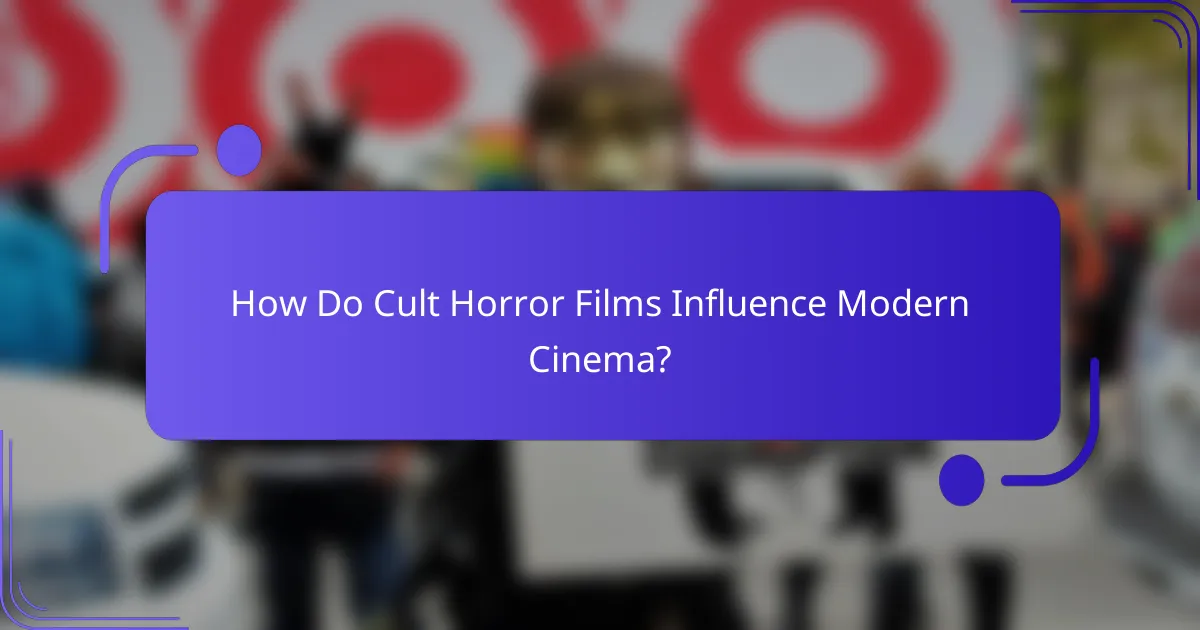
How Do Cult Horror Films Influence Modern Cinema?
Cult horror films significantly shape modern cinema by introducing unique storytelling techniques and aesthetic choices that resonate with audiences. Their influence can be seen in the revival of retro styles and the integration of deeper psychological themes, which challenge traditional narratives and enhance emotional engagement.
Revival of Retro Aesthetics
The resurgence of retro aesthetics in modern horror films draws heavily from the visual and auditory styles of cult classics. Filmmakers often incorporate grainy film textures, vintage color palettes, and synthesizer-heavy soundtracks to evoke nostalgia and create a distinct atmosphere.
Examples include films like “It Follows” and “Stranger Things,” which pay homage to the 1980s horror genre while appealing to contemporary audiences. This blend of old and new not only captivates viewers but also fosters a sense of familiarity and comfort in the unsettling narratives.
Integration of Psychological Themes
Modern horror increasingly explores psychological themes, reflecting the influence of cult films that delve into the human psyche. These narratives often focus on fear, trauma, and existential dread, encouraging viewers to confront their own vulnerabilities.
Films such as “Hereditary” and “Midsommar” exemplify this trend, using character-driven stories to create tension and emotional depth. By prioritizing psychological horror over traditional jump scares, filmmakers engage audiences on a more profound level, making the experience both unsettling and thought-provoking.
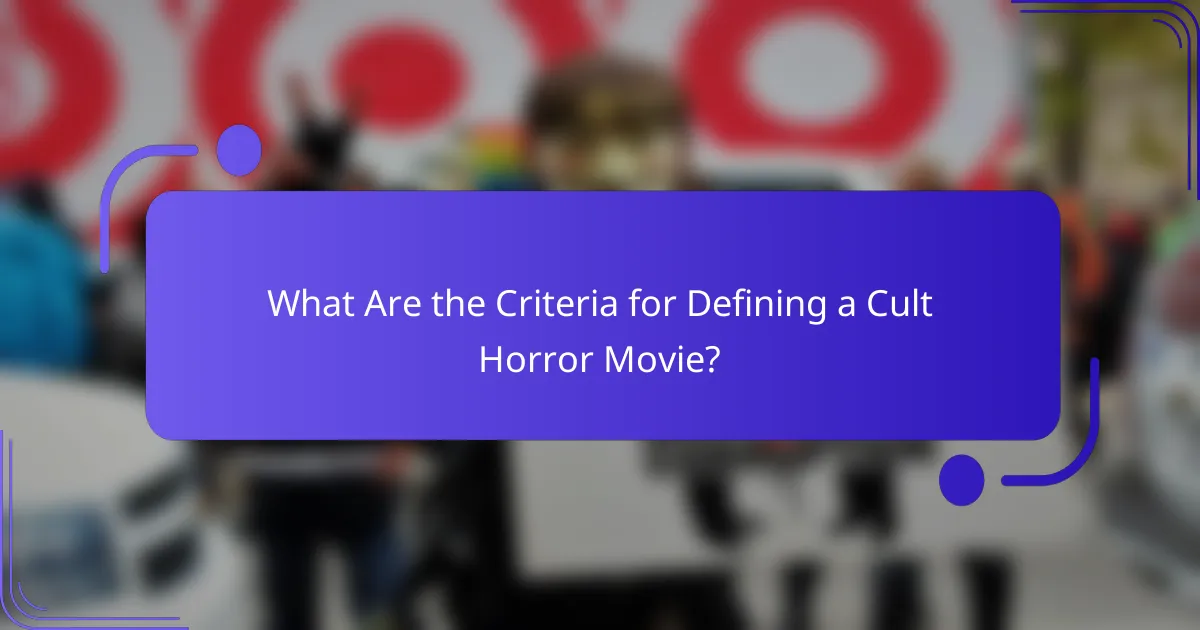
What Are the Criteria for Defining a Cult Horror Movie?
Cult horror movies are defined by their dedicated fan bases, unique storytelling, and significant cultural impact. These films often challenge mainstream conventions, creating a distinct atmosphere that resonates emotionally with audiences.
You can explore the unique atmosphere of these films through their memorable cult horror movie soundtracks.
Fan Following and Cultural Impact
A cult horror movie typically garners a passionate following that transcends its initial release. Fans often engage in discussions, create fan art, and participate in themed events, contributing to the film’s longevity and cultural relevance.
Examples include films like “The Rocky Horror Picture Show,” which has inspired midnight screenings and audience participation, and “Eraserhead,” known for its surreal imagery and devoted fan community. These films often become touchstones for subcultures, influencing fashion, music, and other media.
Unique Storytelling Techniques
Cult horror films often employ unconventional narrative structures and themes that set them apart from mainstream horror. Techniques such as non-linear storytelling, unreliable narrators, and surreal visuals can create a disorienting yet captivating experience for viewers.
For instance, “Donnie Darko” blends psychological thriller elements with science fiction, while “The Witch” uses historical dialogue and slow pacing to build tension. These storytelling choices enhance emotional resonance, making the films memorable and impactful.
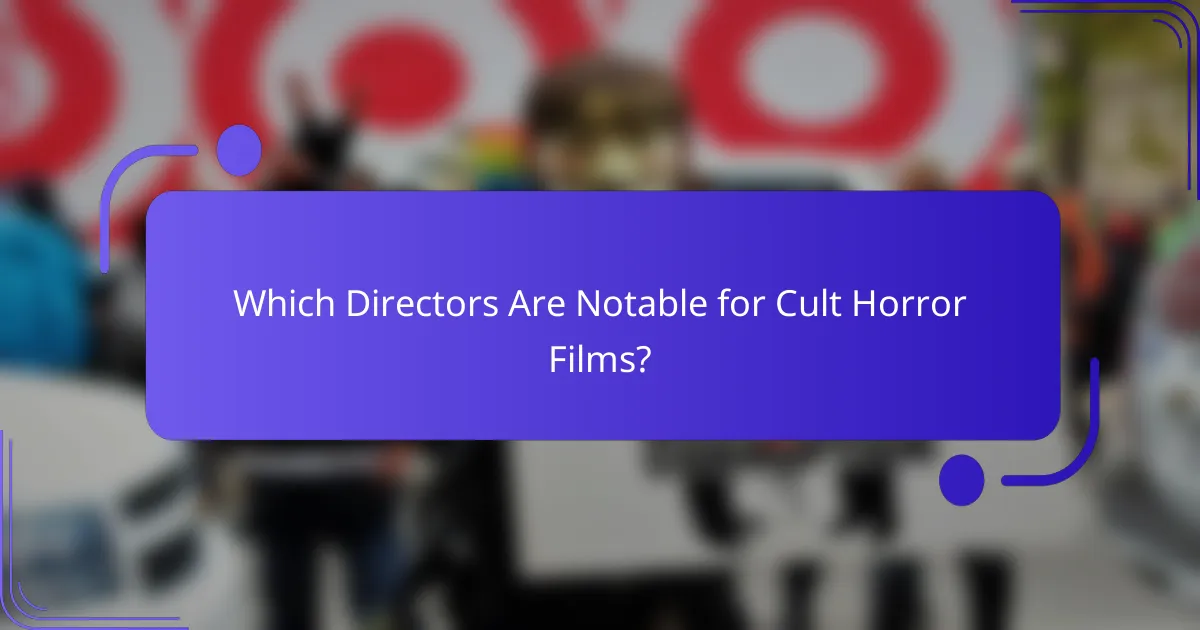
Which Directors Are Notable for Cult Horror Films?
Several directors have become iconic for their contributions to cult horror films, each bringing a unique style and vision. Notable names include John Carpenter, Dario Argento, and David Lynch, who have created unforgettable cinematic experiences that resonate with audiences.
John Carpenter
John Carpenter is renowned for his mastery of suspense and atmospheric storytelling in cult horror cinema. His films often feature minimalist scores, with “Halloween” being a prime example, where the music itself becomes a character that enhances the tension.
Carpenter’s use of practical effects and innovative camera techniques creates a sense of realism that draws viewers into the horror. His work emphasizes the importance of pacing and mood, making even simple settings feel ominous and engaging.
Dario Argento
Dario Argento is a pivotal figure in the Italian horror genre, known for his visually striking films that blend horror with art. His signature style includes vibrant colors, elaborate set designs, and intricate plots, as seen in “Suspiria,” which is celebrated for its haunting visuals and chilling score.
Argento’s films often explore themes of psychological horror and the supernatural, utilizing suspenseful storytelling and shocking twists. His influence can be seen in the way modern horror films approach visual storytelling and sound design.
David Lynch
David Lynch’s approach to horror is deeply psychological, often blurring the lines between reality and nightmare. Films like “Mulholland Drive” and “Eraserhead” showcase his unique ability to evoke fear through surreal imagery and unsettling soundscapes.
Lynch’s work challenges viewers to confront their own interpretations of fear and reality, making his films both disturbing and thought-provoking. His emphasis on atmosphere over traditional horror tropes sets him apart, creating a lasting impact on the genre.
